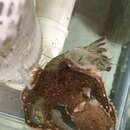Comprehensive Description
provided by Smithsonian Contributions to Zoology
Octopus fangsiao etchuanus (Sasaki, 1929)
DIAGNOSIS.—With the characters of O. f. typicus, below, except as follows: mantle wide (MWI approximately 100); ligula moderate in size (LLI 8–10), HASC 89–90; eggs moderate to large, capsule 13 mm long. Mantle granulose; circumocular papillae subequal in size.
ORIGINAL DESCRIPTION.—Sasaki, 1929:53, pl. 3: figs. 19, 20, pl. 10: figs. 4–10.
TYPE LOCALITY.—Western North Pacific Ocean, Japan, Toyama Prefecture.
TYPES.—Syntypes: ACS, 8 males, 6 females, 43–70 mm ML.
DISTRIBUTION.—Japan, Okayama Prefecture, Nagasaki, Toyama Prefecture.
- bibliographic citation
- Voss, N. A. and Sweeney, M. J. 1998. "Systematics and Biogeography of cephalopods. Volume II." Smithsonian Contributions to Zoology. 277-599. https://doi.org/10.5479/si.00810282.586.277
Comprehensive Description
provided by Smithsonian Contributions to Zoology
Octopus ocellatus Gray, 1849
DIAGNOSIS.—Animal small to medium-sized (35 mm ML). Mantle narrower than long (MWI 80), widest in posterior ; neck slightly constricted; head narrower than mantle (HWI 60). Funnel organ W-shaped, inner and outer limbs subequal in length. Arms long (ALI 84), stout basally, slender distally, arm formula III = IV > II > I. Suckers moderate in size (SIn 11); 1 or 2 especially enlarged suckers on arms II and III (SIe 17.4) of males. Right arm III of males hectocotylized (FAI 77); ligula short (LLI 6.8), slender, with narrow, shallow groove; calamus large (CLI 32), HASC 91. Web shallow to moderate (WDI 19), web formula E > C = D > B > A. Gill lamellae 7. Penis small to moderate in length (PLI 20), curved. Surfaces of mantle, head, and arms covered with closely spaced papillae, flattened posteriorly but more projecting anteriorly; papillae also on dorsal side only of arms; 2 supraocular papillae on each side of head. Ventrally, papillae on each side of funnel extend to base of dorsal surface of arms IV; few small papillae on ventrolateral corner of mantle. Color in preservation (ethanol) light brownish with dark longitudinal bands. Four full bands on mantle with weak band at corner of mantle aperture and below eyes; 5 bands across length of head, 1 each across eye; 3 bands on base of arms, 1 central band divided anteriorly; 1 dark band on dorsal side of each arm. Ocellus present about halfway between eye and sector C of web; ocellus consists of dark central spot surrounded by clear narrow ring enclosed in turn by dark outer ring; indistinct orange brown area between and slightly posterior to eyes.
ORIGINAL DESCRIPTION.—Gray, 1849:15.
TYPE LOCALITY.—“China Seas” [sic].
TYPE.—Holotype: BMNH 1928.12.6.5, male, 35 mm ML.
DISTRIBUTION.—Due to the confusion concerning the ocellated octopods, the distribution outside of Japan and China is unknown.
- bibliographic citation
- Voss, N. A. and Sweeney, M. J. 1998. "Systematics and Biogeography of cephalopods. Volume II." Smithsonian Contributions to Zoology. 277-599. https://doi.org/10.5479/si.00810282.586.277
Comprehensive Description
provided by Smithsonian Contributions to Zoology
Octopus brocki Ortmann, 1888
DIAGNOSIS.—Animal medium-sized (53 mm ventral ML). Mantle oval (37 mm MW); head short and narrow (21 mm HW). Arms subequal, slender, about twice as long as body. Proximal 5 to 6 suckers uniserial, suckers become biserial distally; 5th and 6th suckers on arms II and III especially enlarged in females. Ligula small, with central longitudinal groove. Skin smooth, papillae absent. Greenish blue iridescent ring between bases of arms III and IV.
ORIGINAL DESCRIPTION.—Ortmann, 1888:645,pl.21: fig.4, pl.22: fig.1.
TYPE LOCALITY.—Western North Pacific Ocean, Japan, Tokyo Bay and Kagoshima.
TYPES.—Syntypes: Not traced; 6 females (Tokyo Bay), 2 males, 1 juvenile (Kagoshima). Robson (1929) reported that the two male syntypes are extant in the collections of the UMS.
DISTRIBUTION.—Known only from the type locality.
- bibliographic citation
- Voss, N. A. and Sweeney, M. J. 1998. "Systematics and Biogeography of cephalopods. Volume II." Smithsonian Contributions to Zoology. 277-599. https://doi.org/10.5479/si.00810282.586.277

